Panzerfaust
WW II German Infantry Anti-Tank Weapons
Page 3: Panzerschreck
Panzerschreck Raketen-Panzerbüchse
Raketenpanzerbüchse 43
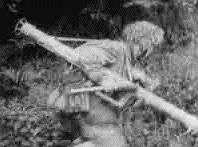
 Development
of this weapon was inspired by the early 1943 capture of american M9A1
Bazookas in the african campaign (Tunisia; other sources: captured lend-lease
bazookas from the Eastern Front). To increase its basic potential it was
decided outright to use a weapon caliber of 8.8cm (3.46 in.) instead of
the Bazooka's 6cm (2.36 in.). It was designated Raketen-Panzerbüchse
("Rocket Tank Rifle") and officially abbreviated RPzB but commonly
referred to as Panzerschreck ("Tank Terror"), among the troops it
was also known simply as the Ofenrohr ("stove pipe").
Development
of this weapon was inspired by the early 1943 capture of american M9A1
Bazookas in the african campaign (Tunisia; other sources: captured lend-lease
bazookas from the Eastern Front). To increase its basic potential it was
decided outright to use a weapon caliber of 8.8cm (3.46 in.) instead of
the Bazooka's 6cm (2.36 in.). It was designated Raketen-Panzerbüchse
("Rocket Tank Rifle") and officially abbreviated RPzB but commonly
referred to as Panzerschreck ("Tank Terror"), among the troops it
was also known simply as the Ofenrohr ("stove pipe").
The major differences to the Panzerfaust were the size and the
fact that the Panzerschreck by design was to be a reloading weapon,
preferrably crew served by trained and dedicated two-man AT teams (gunner
and loader), while the Panzerfaust was a single-use, disposable
close range one-man weapon for use by everybody. Also, the Panzerschrecks
firing mechanism was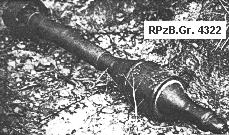 electric (like that of the Bazooka), while the Panzerfaust used
a percussion ignition much like the cartridges of a normal gun.
electric (like that of the Bazooka), while the Panzerfaust used
a percussion ignition much like the cartridges of a normal gun.
The firing tube of the original Panzerschreck model, the Raketenpanzerbüchse
43, was164cm (65 in.) long and weighed 9.25kg (20.4 lb) (empty). The
projectile used was the RPzB.Gr. 4322 (Raketenpanzerbüchsen-Granate
/ "Rocket Tank Rifle Round") that carried a shaped charge of 660g (23.3oz.)
and weighed 3.30kg (7.27 lb.) there was a Sommer ("summer") (used in temperatures
between -5° to +50° Celsius) and a Winter ("winter") (used in temperatures
of -40° to +30° Celsius) version of the RPzB.Gr.4322 that
accounted for the different thermic conditions. The projectile's flight
path was stabilized by a sheet metal stabilizer ring at the rear of its
shaft looking quite similar to those used on aircraft bombs. The propellant
continued to burn even after it left the tube for another 2m (6.5 ft.),
the projectile had then reached its velocity of 105m/s (345 fps). The first
Panzerschreck
model was built only in small numbers.
Raketenpanzerbüchse 54
 Because
of the lack of protection for the gunner against the propellant particles
the weapon was quite unpopular at first. Use of the weapon by front troops
did not increase significantly until an ad-hoc remedy for the problem was
found by giving the gunner an improvised protection composed of a fireproof
poncho and a gas mask (with the filter removed). In early November 1943
the suggestion for a protective shield, submitted by a frontline soldier,
Oberleutnant (First Lieutenant) Riechers of Panzer-Jäger Abteilung
(Tank Hunter Detachment) 229, was implemented into the weapon's design.
Because
of the lack of protection for the gunner against the propellant particles
the weapon was quite unpopular at first. Use of the weapon by front troops
did not increase significantly until an ad-hoc remedy for the problem was
found by giving the gunner an improvised protection composed of a fireproof
poncho and a gas mask (with the filter removed). In early November 1943
the suggestion for a protective shield, submitted by a frontline soldier,
Oberleutnant (First Lieutenant) Riechers of Panzer-Jäger Abteilung
(Tank Hunter Detachment) 229, was implemented into the weapon's design.
This protective shield measured 36 x 47cm (14 x 18.5 in.), set into
the shield was a small mica (a clear mineral) window. It is the most obvious
visible difference between the original RPzB.43 and it's successor
model, the RPzB.54, since immediately all new RPzB.54 were
produced with the new protective shield. This shield also gave the weapon,
which was technically a recoilless design, a "recoil" in form of a nasty
kickback from the projectile's rocket engine's backblast against which
the shield protected the gunner.
Production of the Panzerschreck had changed to this successor model
in October 1943. The new Raketenpanzerbüchse 54 weighed 11kg
(24.2 lb.)(empty). It was also modified to fire the newly developed RPzB.Gr.4992
which with a modificaton of the propellant had a better practical range
(usually cited at 180m). This ammunition too came in a summer and a winter
version.The armor penetration of both RPzB.Gr. 4322 and 4992
was
230mm (9 in.), at a 60° impact angle this figure was reduced to 160mm
(6.3 in.). The ammunition was transported in a carrying frame holding 5
rounds, the wooden supply crates contained 2 rounds.

Initial orders called for 382,000 RPzB.54 to be produced. This
order was later reduced, and by July 1944 production ceased with a total
number of 289,151 delivered. The process of equipping the fighting forces
with Panzerschrecks progressed quite slow, in 1943 comparably few reached
frontline units. By January 1944 21,141 had been issued to combat units,
while another 39,526 lay unused in the armories. Panzerschreck weapons
were produced by the following companies: Enzinger Union in Pfeddersheim,
Gebrüder Scheffler in Berlin, HASAG in Meuselwitz, Jäckel in
Freistadt, Fa. Kronprinz in Solingen and Fa. Schricker in Fürth-Vach.
The next model was the RPzB.54/1. Changes were the reduction
of tube length to now135cm (53.1 in.), which among other changes led to
a reduced weight of 9.5kg (21 lb.). The ignition system was changed: the
contact pin to the missile was changed to a contact ring. Also the sights
were redesigned and improved. Although the weapon officially entered service
at the 20th December of 1944, the first order for this new weapon wasn't
given before early 1945, and of the requested 48,000 only 25,744 had actually
been delivered until the end of the war. The launch tube of this last model
had an expected life span of 200 shots.
The original Panzerschreck model RPzB 43 cost 70 RM (Reichsmark) per
launch tube (w/o ammo) (for comparison, even the smallest pre-war AT gun,
the 3.7 cm PaK 35/36 (hopelessly useless by 1944), cost 5730 RM !). 10
work hours were needed for the completion of one weapon.
Reportedly there also existed a shortened variant of the RPzB 54 with
a tube length of only 107cm; this however seems unlikely and I didn't find
further information on this yet.
A last improvement of the sighting was the development of the so-called
Deckungszielgerät
("cover aiming device") which allowed for an aiming out of concealement,
therefore protecting the operator. An order of 100,000 of these was placed
as late as February 1945.
Another development was the attempt to save resources by manufacturing
the Panzerschreck tube out of impregnated pressed cardboard. Although the
idea worked - weight was reduced by 2kg (4.4 lb) and 5.5kg (12 lb) precious
metal were saved - it did not enter mass production before the war ended.
There was also a special anti-aircraft munition called Fliegerschreck
("airplane terror") in development that was to be fired from the Panzerschreck.
The new ammunition used a new warhead that was simply fitted to the regular
Panzerschreck ammunition. The new warhead was 17.4cm long and had (naturally)
a diameter of 8.8cm, it contained an explosive charge of Nitropenta that
was to distribute 144 small incendiary submunitions. The new ammunition
came together with a new aiming device, a simplified round bead like the
ones used on AA - machineguns, that could be attached to the Panzerschreck
for it's role as an AA weapon. Development of the new weapon was finished
by January 1945; 500 of the new warheads were produced but none were used
in the planned combat trials.
Panzerschreck Usage
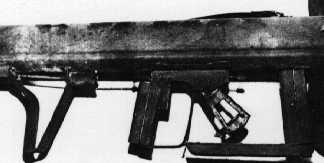 To
prepare the weapon for firing, the RPzB.Gr. projectile had to be inserted
into the rear of the weapon. The gunner had two triggers to pull: The first
trigger cocked the magnetic ignition system. The second trigger released
it: a small magnetic rod was pushed into a coil winding, thereby generating
(through magnetic induction) a small electrical current which was conducted
via wiring to the rear of the tube where it ignited the projectile's rocket
motor.
To
prepare the weapon for firing, the RPzB.Gr. projectile had to be inserted
into the rear of the weapon. The gunner had two triggers to pull: The first
trigger cocked the magnetic ignition system. The second trigger released
it: a small magnetic rod was pushed into a coil winding, thereby generating
(through magnetic induction) a small electrical current which was conducted
via wiring to the rear of the tube where it ignited the projectile's rocket
motor.
 Aiming
was done via a simple sighting device (see sketch at left) consisting of
two metal hooks, one serving as the notch, the other one as bead with little
inset bars for the different ranges of 100, 150 and 200m (RPzB.54/1). The
bead part of the sight also had to be repositioned to account for the different
characteristics of both the RPzB.Gr. 4322 and 4992 and the respective summer
and winter versions of these ammuntions.
Aiming
was done via a simple sighting device (see sketch at left) consisting of
two metal hooks, one serving as the notch, the other one as bead with little
inset bars for the different ranges of 100, 150 and 200m (RPzB.54/1). The
bead part of the sight also had to be repositioned to account for the different
characteristics of both the RPzB.Gr. 4322 and 4992 and the respective summer
and winter versions of these ammuntions.
The backblast of  the
Panzerschreck was even more dangerous than that of the Panzerfaust. Therefore,
as explained above, with the early model the operator had to wear a kind
of fireproof poncho and a gas mask (with the filter removed) for protection
against the backblasting propellant particles. As stated abvove, the propellant
continued to burn for another 2m (6.5 ft) even after it had left the launch
tube. Later the protective shield cured this problem.
the
Panzerschreck was even more dangerous than that of the Panzerfaust. Therefore,
as explained above, with the early model the operator had to wear a kind
of fireproof poncho and a gas mask (with the filter removed) for protection
against the backblasting propellant particles. As stated abvove, the propellant
continued to burn for another 2m (6.5 ft) even after it had left the launch
tube. Later the protective shield cured this problem.
The common tactic for hunting or defending against tanks from 1944 on
was the use of special anti-tank teams, so-called "Panzerzerstörergruppen"
("tank destroyer groups"), 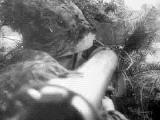 which
consisted of two squads with 3 Panzerschreck each. They were to cover each
other which provided some problems in deployment due to the limited range
of these weapons.
which
consisted of two squads with 3 Panzerschreck each. They were to cover each
other which provided some problems in deployment due to the limited range
of these weapons.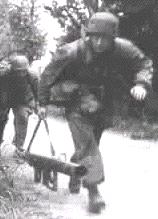
The Panzerschreck was even used at night: an illuminating flare round
then had to be fired behind the enemy tank in order to let the tank silhouette
stand out against the bright background.
The Panzerschrecks were initially less successful
than Panzerfausts because Panzerschreck gunners - trusting in the impressive
size of the Panzerschreck - tended to open fire at larger ranges of around
100m (330 ft.), which was also necessified by the relative cumbersomeness
of the large Panzerschreck which was a hindrance when retreating into cover
after the shot. Panzerfausts were easier to handle and usually shot from
a distance of 30m (100 ft.) after which the soldier quite easily could
get under cover again.
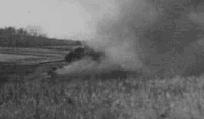 At
early
trials, out of 12 Panzerschreck rounds fired
at a static T-34 at a range of 100m only 3 hit the target.
At
early
trials, out of 12 Panzerschreck rounds fired
at a static T-34 at a range of 100m only 3 hit the target.
In the same trial all of the five Panzerfausts fired at a range of
30m hit the tank - however one should keep in mind that this was a static
target that did not shoot back!
CLICK HERE TO SEE SOME PICTURES FROM
THE TRIALS (Panzerschreck shooting at target tank)
Engagement Range
There is still some controversy around the range of this weapon. Sources
give figures for anything from 150m to 1,000m as range: The Panzerschreck's
technical data call for a theoretical engagement range of 700m (!), practical
engagement ranges are usually cited with 400m for static targets and 100
to 230m for moving targets. Then again, an army report on the fighting
around Posen dated March 1st 1945 emphasizes the effectiveness of the Panzerschreck
and states that static targets such as AT gun and infantry emplacements
had been successfully attacked at ranges up to 1000m (!). Engagement procedures
called for the Panzerschreck teams to open fire against attacking (oncoming)
tanks at 180-150m. Laterally moving tanks were to be attacked at a range
of 120m. These later figures of course take into account the fact that
fire should only be opened (and hence the chance of detection and counter
fire) when a high chance of hit probability is given.
Many factors influence the weapon's range, amongst these the type of
ammunition used (4992 had a higher range), the temperature, size &
type and speed vector of the target. A swiss instructor for the B+W Raketenrohr
58/80, a swiss license-built of the belgian Blindicide, which was a pretty
straightforward post-war Panzerschreck derivative (although the Blindicide
and the Raketenrohr were not direct copies of the Panzerschreck, they are
fairly identical in system, handling and operational parameters; official
range data: the Blindicide had sights adjustable from 100 - 400 meters,
and a special sight for 700meters. Official manufacturer data for the swiss
weapon were 300m vs static and 200m vs moving targets) contributed the
following:
"Our regulation state a maximum range of 300 meters, but in NCO school
our instructor told us to reduce it to 250 meters max for static targets
and 200 for moving targets. (...) A 400m range is right on for engagement
of non-moving large targets, such as buildings or pillboxes, against which
AT weapons are effective. A 1000m range is reachable only through the use
of a parabolic trajectory, and I imagine that more than one round was fired.
(...) Parabolic-trajectory firing of the RR80 was not cited in the manual
for fighting enemy infantry emplacements (I suspect the tactic went against
Wehrmacht doctrine as well and was used by soldiers as an ad hoc alternative
to mortar fire) but it was allowed for avalanche detachment. A sight attachment
existed which allowed the gunner to properly aim the weapon this way. The
engagement drill procedure were still valid with the RR80 10 years ago.
We had a graphic scheme on the RR80 shield that told the gunner
exactly where to aim depending on sight elevation (which had 3 settings:
150, 200 (combat), 250), target speed and windspeed. Fire was usually commanded
personally by the group leader (a corporal) who had to spell out the engagement
data for the teams (target designation, target distance and speed) and
who had to check for correct identification by the gunners. (...) We had
a minimum range of 50 meters since the RR80 round fuse didn't arm itself
before 15 meters, and there must be at least 50 meters between you and
the target in order to survive the engagement. An exploding tank is not
the safest thing to be near to..."
He also mentioned in regard to the last time he fired the Raketenrohr,
in 1994, where he managed to hit all 4 assigned targets:
"They were at ranges of 150 to 250 meters. They were not moving but
we were under time constraint - 30 seconds to engage them all. 30 seconds
is an eternity under combat conditions, but it always takes the greatest
toll on the loader, since he has to load all the rounds, make sure the
tube is clear, arm the weapon and clear the danger area, which extended
from the rear of the tube up to 50 meters in length and 4 meters to the
sides."
Panzerschreck 10,5cm
In August 1944 an enlarged version of the Panzerschreck was suggested.
The caliber of this new Panzerschreck was to be 10.5cm (4.13 in.). The
first prototype weighed 18kg (39.6 lb) and was 2.40m (7.87 ft.) long. The
projectile weighed 6.1kg (13.43 lb), range was up to 300m (330 yd.), armor
penetration was 180mm (7.09 in.) (60° impact angle). The proposed weapon
was rejected: the new weapon was to be less cumbersome and lighter, also
an armor penetration of 240mm (9.45 in.) was requested. Therefore the next
model had a shortened tube of 200cm (6.56 ft.), weight was reduced to 13kg
(28.6 lb). The proposed projectile now weighed 6.3kg (13.87 lb) with a
shaped charge of 1.3kg (2.86 lb) which made for an armor penetration of
220mm (8.66 in.) (again at 60° angle). But recoil forces now became
a problem and experiments with a small mount took place. The end of the
war ended this development; none of these Panzerschreck 10,5cm -
models ever saw active service.
Panzerjäger Bren 731(e)
The Panzerschreck also constituted the main armament of what was probably
the first armored vehicle in history equipped with AT rockets, the Panzerjäger
Bren 731(e) ("tank hunter" Bren, consecutive foreign vehicle type number
731, "e" for english origin). The original german 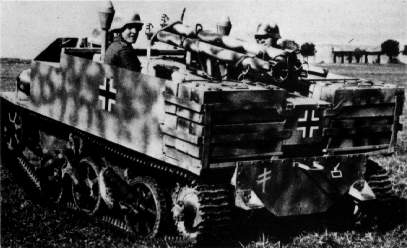 concept
of a small tank saw the development of a vehicle in the 6 - 10 ton range
under the designation E-5 Wanze ("bedbug"). (see below).
concept
of a small tank saw the development of a vehicle in the 6 - 10 ton range
under the designation E-5 Wanze ("bedbug"). (see below).
In the meantime the germans had captured a number of the english Bren
carrier armoured tracked vehicles during the course of the war. They were
found most useful and therefore used in german service under the foreign-vehicle
designation Bren 731(e).
Among other uses - most served as machine-gun carriers, others were
equipped with 3,7cm PaK AT guns as tank hunters - they were converted to
improvised tank destroyers with a mount of three Panzerschreck tubes
and utilised by the Panzer-Zerstörergruppen ("tank-destroyer groups")
who also took with them other AT weapons such as the Panzerfaust. The conversions
were done by the field maintenance shops. The Bren vehicle had a length
of 3.65m (12 ft.), a width of 2.05m (6 ft. 9 in.) and a height of 1.60m
(5 ft. 2 in.). It weighed 4 tons, was armoured up to 12mm (0.47 in.) and
used an 85hp Ford V-8 engine that made the little tank destroyer comparably
agile and enabled it of speeds of up to 35mph. The Panzerjäger
Bren was used mainly on the Eastern Front.
The triple RPzB 54 mounts which can be seen in the picture was also
fitted to some SdKfz 251 halftracks and even Kübelwagen jeeps; in
the army administrative papers of Jan. 15th 1945 a detailed instruction
for the mounting of triple Panzerschreck launchers onto SdKfz 251
armored halftrack personnel carriers was publicized which was intended
for the tank-hunters of the mechanized infantry Panzergrenadier-battallions.
E-5 Wanze Ausf m RPzB 54
The german army's weapon's bureau had a series of projected future tank
designs, the so-called E-types (E = Entwicklung "development"), wherein
the E-number roughly corresponded with the weight class of the vehicle.
The smallest such design in the 5-ton class was the E-5 mini tank.
The requirements called for a fast minitank, to be used in the antitank
role and as machine gun carrier, with no more than 6 - 10 tons of weight
and one or two crewmen. The projected minitank was given the name Wanze
("bedbug"). Several different concepts were proposed by the companies Daimler,
Steyr, Büssing, Weserhütte; a model by BMW was even built in
one prototype, the vehicle had a length of 3,55m and had a 90 hp engine.
However, no final decision was made until March 1945, when the whole projected
models all were rejected by the Inspector General of Tanks.
Panzerjäger Borgward B
IVc Ausf m RPzB 54
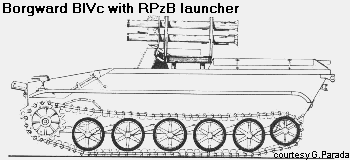 However,
there are reports of a few similar vehicles actually built and used in
the defense of Berlin, the vehicle in question was the Borgward B IV
Ausführung mit Raketenpanzerbüchse 54 (Borgward as the company's
name; "version with rocket tank rifle").
However,
there are reports of a few similar vehicles actually built and used in
the defense of Berlin, the vehicle in question was the Borgward B IV
Ausführung mit Raketenpanzerbüchse 54 (Borgward as the company's
name; "version with rocket tank rifle").
The company Borgward had been building the B-series "Minenräumwagen"
("mineclearing vehicles") load carriers. The later vehicles in the series
were supposed to carry a demolition charge into the minefield. This resulted
in the B-IV, which was ordered by the Heereswaffenamt under the
designation schwerer Ladungsträger ("heavy charge carrier").
It was operated by remote control; on the front it carried a detachable
explosive charge of 500kg which it placed in the minefield that was supposed
to be cleared. The original version Borgward B IVa from as early
as October 1940 weighed 3.45t, had a length of 3.65m, a width of 1.80m
and a height of 1.185m and was powered by a Borgward engine with 49hp.
The internal fuel capacity of 130l allowed for an operating range of around
120km cross-country. Instead of the remote control it could alternately
be operated conventionally by a driver; armor plating to the front and
sides had a strength of 10mm. Original contract cost was 28,000 RM apiece.
The Borgward vehicles in general didn't prove to be as widespread as their
smaller brethren, the Goliath remote-controlled tracked explosive
charge vehicles.
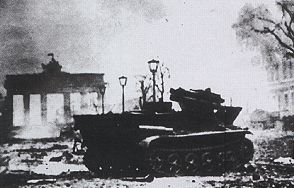 In
April 1942 the first 15 vehicles were handed over to the Waffenamt; a last
major production batch of the original A-version was delivered in June
1943. After that, the successor version B-Ausführung ("B-version")
had stronger armor plating which increased weight to almost 4t, and 260
were produced until November 1943. The final production version was the
B
IVc model. Dimensions were 4.10m length, 1.83, width and 1.25m height,
it had a 6-cyl. Borwgard engine of 3.75l which had a performance of 78hp
which gave the vehicle a maximum speed of 40km/h. Armor thickness had been
increased to 20mm at front and sides which increased the total weight to
roughly 5t; 305 were produced.
In
April 1942 the first 15 vehicles were handed over to the Waffenamt; a last
major production batch of the original A-version was delivered in June
1943. After that, the successor version B-Ausführung ("B-version")
had stronger armor plating which increased weight to almost 4t, and 260
were produced until November 1943. The final production version was the
B
IVc model. Dimensions were 4.10m length, 1.83, width and 1.25m height,
it had a 6-cyl. Borwgard engine of 3.75l which had a performance of 78hp
which gave the vehicle a maximum speed of 40km/h. Armor thickness had been
increased to 20mm at front and sides which increased the total weight to
roughly 5t; 305 were produced.
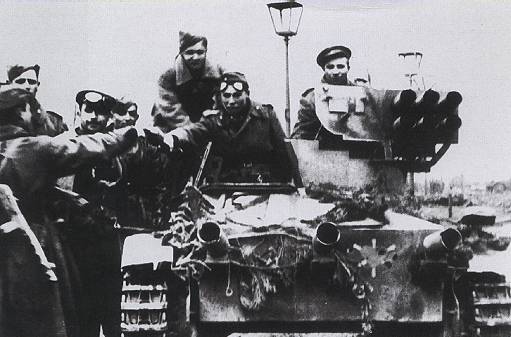 A
few of these in an improvisation were modified as Panzerjäger
("tank hunters"); they were armed with a sixfold RPzB.54 arrangement offset
to the left side of the vehicle (the driver compartment was offset to the
right in all Borgward IV vehicles); the launcher was rotatable and offered
a protective shield. It was intended to engage enemy armor at short distance
in a shotgun-like manner with the six Panzerschreck tubes. A few of these
saw actual combat in the defence of Berlin in the closing days of the war.
The small picture above shows an abandoned Borgward before the background
of the Brandenburg Gate landmark in Berlin's center. The picture at right
apparently shows Russian soldiers (notice uniform and PPSh-41) with a captured
tank-hunter Borgward (pictures via R.Waugh).
A
few of these in an improvisation were modified as Panzerjäger
("tank hunters"); they were armed with a sixfold RPzB.54 arrangement offset
to the left side of the vehicle (the driver compartment was offset to the
right in all Borgward IV vehicles); the launcher was rotatable and offered
a protective shield. It was intended to engage enemy armor at short distance
in a shotgun-like manner with the six Panzerschreck tubes. A few of these
saw actual combat in the defence of Berlin in the closing days of the war.
The small picture above shows an abandoned Borgward before the background
of the Brandenburg Gate landmark in Berlin's center. The picture at right
apparently shows Russian soldiers (notice uniform and PPSh-41) with a captured
tank-hunter Borgward (pictures via R.Waugh).
Previous Page : Faustpatrone
& Panzerfaust Main Page Next
Page : Production Figures, Foreign Use
© 1998, 1999, 2000, 2001 created by M.Hofbauer August
29th 1998; document ver. 1.4 mod 150102
This page has been constructed with own material as far
as possible, the third party images and information used herein are public
domain to the best of my knowledge. The author went to considerable lengths
to ensure accordance with the rights of copyright owners where applicable;
respective consent is documented. If you feel injured in your rights by
/ take offense at - any part of this page's content contact
me immediately for redress / possible removal of the respective part.

 electric (like that of the Bazooka), while the Panzerfaust used
a percussion ignition much like the cartridges of a normal gun.
electric (like that of the Bazooka), while the Panzerfaust used
a percussion ignition much like the cartridges of a normal gun.
 Because
of the lack of protection for the gunner against the propellant particles
the weapon was quite unpopular at first. Use of the weapon by front troops
did not increase significantly until an ad-hoc remedy for the problem was
found by giving the gunner an improvised protection composed of a fireproof
poncho and a gas mask (with the filter removed). In early November 1943
the suggestion for a protective shield, submitted by a frontline soldier,
Oberleutnant (First Lieutenant) Riechers of Panzer-Jäger Abteilung
(Tank Hunter Detachment) 229, was implemented into the weapon's design.
Because
of the lack of protection for the gunner against the propellant particles
the weapon was quite unpopular at first. Use of the weapon by front troops
did not increase significantly until an ad-hoc remedy for the problem was
found by giving the gunner an improvised protection composed of a fireproof
poncho and a gas mask (with the filter removed). In early November 1943
the suggestion for a protective shield, submitted by a frontline soldier,
Oberleutnant (First Lieutenant) Riechers of Panzer-Jäger Abteilung
(Tank Hunter Detachment) 229, was implemented into the weapon's design.

 To
prepare the weapon for firing, the RPzB.Gr. projectile had to be inserted
into the rear of the weapon. The gunner had two triggers to pull: The first
trigger cocked the magnetic ignition system. The second trigger released
it: a small magnetic rod was pushed into a coil winding, thereby generating
(through magnetic induction) a small electrical current which was conducted
via wiring to the rear of the tube where it ignited the projectile's rocket
motor.
To
prepare the weapon for firing, the RPzB.Gr. projectile had to be inserted
into the rear of the weapon. The gunner had two triggers to pull: The first
trigger cocked the magnetic ignition system. The second trigger released
it: a small magnetic rod was pushed into a coil winding, thereby generating
(through magnetic induction) a small electrical current which was conducted
via wiring to the rear of the tube where it ignited the projectile's rocket
motor.
 the
Panzerschreck was even more dangerous than that of the Panzerfaust. Therefore,
as explained above, with the early model the operator had to wear a kind
of fireproof poncho and a gas mask (with the filter removed) for protection
against the backblasting propellant particles. As stated abvove, the propellant
continued to burn for another 2m (6.5 ft) even after it had left the launch
tube. Later the protective shield cured this problem.
the
Panzerschreck was even more dangerous than that of the Panzerfaust. Therefore,
as explained above, with the early model the operator had to wear a kind
of fireproof poncho and a gas mask (with the filter removed) for protection
against the backblasting propellant particles. As stated abvove, the propellant
continued to burn for another 2m (6.5 ft) even after it had left the launch
tube. Later the protective shield cured this problem.
 which
consisted of two squads with 3 Panzerschreck each. They were to cover each
other which provided some problems in deployment due to the limited range
of these weapons.
which
consisted of two squads with 3 Panzerschreck each. They were to cover each
other which provided some problems in deployment due to the limited range
of these weapons.

 concept
of a small tank saw the development of a vehicle in the 6 - 10 ton range
under the designation E-5 Wanze ("bedbug"). (see
concept
of a small tank saw the development of a vehicle in the 6 - 10 ton range
under the designation E-5 Wanze ("bedbug"). (see 